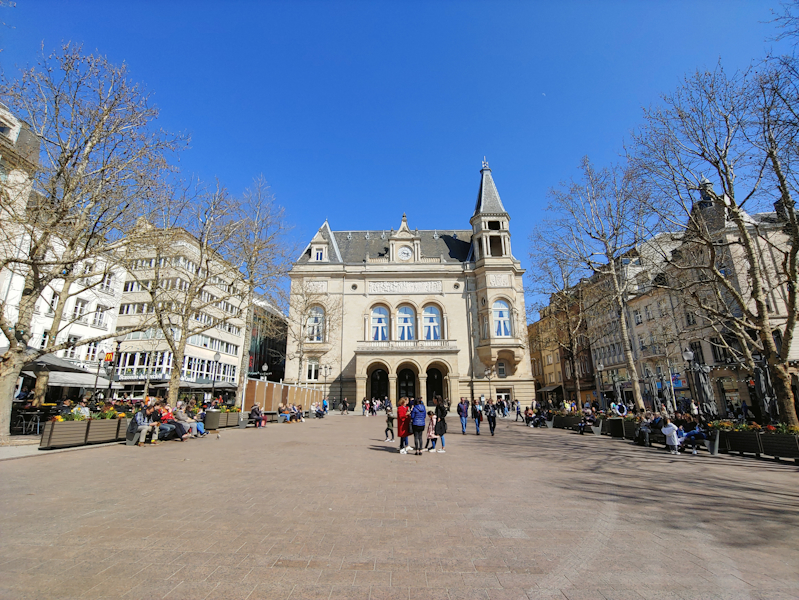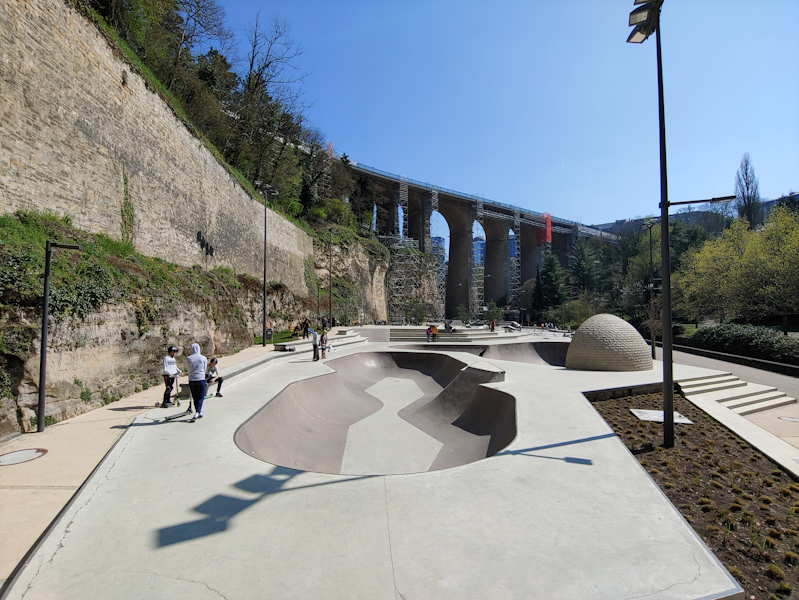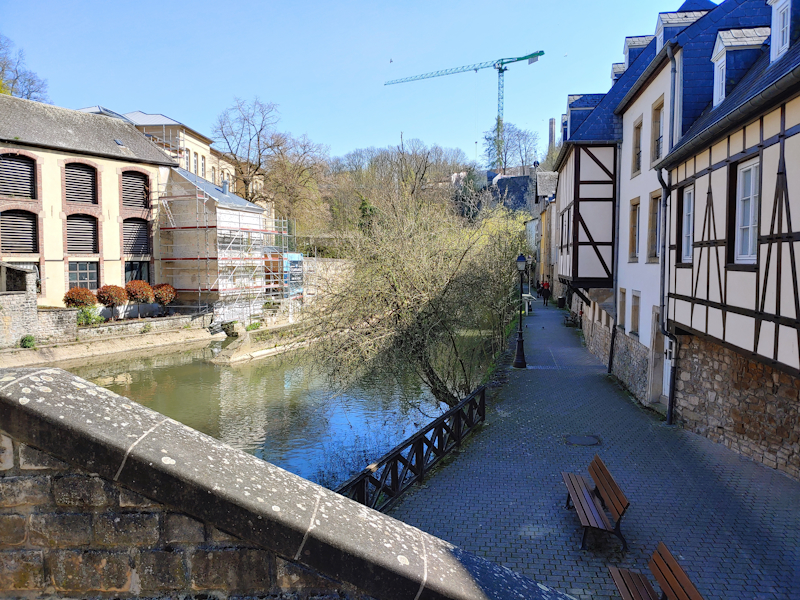The LG G8 Review: Solid, But Not Great
by Andrei Frumusanu on April 30, 2019 1:00 PM EST- Posted in
- Mobile
- LG
- Smartphones
- LG G8
- LG G8 ThinQ
Camera - Daylight Evaluation
We move on to the G8’s camera. Again this is a controversial topic as it was one of the areas where the G7 last year failed quite terribly, particularly on the matter of post-processing where the phone’s camera kept applying needless noise-reduction filters which blurred out details and made things look like watercolour paintings.
The G8 needs to redeem itself not only in this regard, but also needs to compete with excellent new cameras from the competition.
Among the differenes between the G7 and G8 is that the new 12MP sensor and f/1.5 aperture lens module comes with a slightly wider viewing angle on the main camera. Also it will be interesting to see the differences between the V40 and G8 as both have the same module, but different SoCs which will impact processing results.
For this review, I’ll also be taking a better look at LG’s AI Cam mode as since the V40 this capture mode is more balanced in terms of the results and overall I’ve deemed it to be an overall benefit to the camera.

[ G8 ] - [ G7 ]
[ V40 ] - [ P30 Pro ]
[ P30 ] - [ P20 Pro ]
[ P20 ] - [ Mate 20 Pro ]
[ S10+ (S) ] - [ S10+ (E) ] - [ S9+ (S) ]
[ View20 ] - [ OnePlus 6T ] - [ Pixel 3 ] - [ iPhone XS ]
Starting off with the main camera, we see in this first scene that the G8 produces much better results than the G7 with significantly better dynamic range and detail. LG seems to have toned down the noise reduction in subsequent firmware updates to the G7 which was one of its worst behaviours.
The AI mode helps the a tad darker and unsaturated result of the Auto mode on the G8, but for this scene it’s not as dramatic a difference as seen on the V40. I actually like the V40’s AI mode here as it’s a better representation of the scene under a cloud-free sky with the bright sun. Both the G8 and V40 in this mode have nearly the same exposure time yet the V40’s processing brings out better dynamic range and contrast.
The G8’s competition here is clearly the Galaxy S10. The LG device has better saturations, however Samsung is able to bring out more shadow details, especially on the shadow-cast wall in the middle of the scene.
While LG has improved its usage of noise reduction, the G8 still evidently uses some, along with a combination of a sharpening filter. On some parts of the scene this works ok, but for example in the middle left trees this gives an unnatural sharpening to the foliage compared to the Galaxy S10.
Wide-angle shots on the G7 could be pretty terrible, and this is one scene where the G8 again improves dramatically in this regard, having much better colours, details and dynamic range.
Oddly enough, again the G8’s AI mode doesn’t produce as nearly nice results as the V40’s, which although lacks detail, has excellent colours and dynamic range contrast.

[ G8 ] - [ G7 ]
[ V40 ] - [ P30 Pro ]
[ P30 ] - [ P20 Pro ] - [ P20 ]
[ Mate 20 Pro ] - [ S10+ (S) ] - [ S10+ (E) ]
[ S9+ (S) ] - [ View20 ] - [ OnePlus 6T ]
[ Pixel 3 ] - [ iPhone XS ]
The next scene the difference between the G7 and G8 is night and day. The former phone’s histogram in this picture is just sad too look at as it avoids the last 10% completely while having most content dynamic range in the 5-50% levels, which is absurd considering this picture is captured in broad daylight. The G8 is just much better in capturing the proper highlights while still maintaining shadows correctly.
The AI mode brightens things even a little bit further, in an even better representation of the bright scene. I would say I prefer the G8’s shot here over the V40 as the latter compresses things a bit too much.
Again the G8 here competes with the S10, although again in terms of details it lags behind as its noise reduction and sharpening is too aggressive, losing out details such as the roof tiles in the first building from the bottom.
The wide-angle lens is again a major step-up compared to what we see on the G7. Unfortunately when it comes to detail on the wide angle, LG still very much lags behind Huawei and now Samsung.

[ G8 ] - [ G7 ]
[ V40 ] - [ P30 Pro ]
[ P30 ] - [ P20 Pro ] - [ P20 ]
[ Mate 20 Pro ] - [ S10+ (S) ] - [ S10+ (E) ]
[ S9+ (S) ] - [ View20 ] - [ Pixel 3 ] - [ iPhone XS ]
Although the G8 has less resolution than the G7, its camera actually has the better spatial resolution when it comes to details, and in this scene it’s evident that it’s not just a matter of the post-processing.
The differences between the G8 and V40 are more nuanced, and I like the new phone’s better preservation of highlights. The G8 is ahead in terms of colours and exposure, however it again lags behind in detail to the Galaxy S10.
In terms of the wide angle, this shot wasn’t great for any of the LG phones. Particularly the texture of the pavement on the G8 is quite terrible when compared to what Huawei and Samsung are producing.

[ G8 ] - [ G7 ]
[ V40 ] [ P30 Pro ] - [ P30 ]
[ P20 Pro ] - [ P20 ]
[ Mate 20 Pro ] - [ S10+ (S) ] - [ S10+ (E) ]
[ S9+ (S) ] - [ View20 ] - [ OnePlus 6T ]
[ Pixel 3 ] - [ iPhone XS ]
On the main camera, the G8’s AI mode here happens to capture a nearly identical composition to the S10 even though the latter’s exposure is twice as long because of the f/2.4 aperture in bright scenarios. I like the G8’s colours more, however details again seem to go to Samsung.
This is again as scene where the V40’s HDR processing is a lot more aggressive which results in toned down highlights, while the G8 preserves them better.
Exposure on the wide angle is very good on the G8 however again can’t compete in terms of detail to Huawei and Samsung.

[ G8 ] - [ G7 ]
[ V40 ] [ P30 Pro ]
[ P30 ] - [ P20 Pro ] - [ P20 ]
[ Mate 20 Pro ] - [ S10+ (S) ]
[ S10+ (E) ] - [ S9+ (S) ] - [ View20 ] - [ OnePlus 6T ]
[ Pixel 3 ] - [ iPhone XS ]
This shot is quite hard on the cameras as it’s captured against the sun. Nevertheless, some phones manage to produce good results, however the LG phones all fail at the scene. The G8 isn’t able to maintain a black point and has no levels at all below 30% which results in a washed out image lacking contrast.
We see a similar issue on the wide-angle, with no levels below ~15%. Both the G8 and V40 showcase almost identical lens flares, pointing out to lesser quality optics and anti-reflection coatings on the lenses than say Huawei’s wide angle modules.

[ G8 ] - [ G7 ]
[ V40 ] [ P30 Pro ] - [ P30 ]
[ P20 Pro ] - [ P20 ] - [ Mate 20 Pro ]
[ S10+ (S) ] - [ S10+ (E) ] - [ S9+ (S) ]
[ View20 ] - [ OnePlus 6T ] - [ Pixel 3 ] - [ iPhone XS ]
In the last scene here again the G8 represents big improvements over both the G7 and V40, with better details and dynamic range and accurate colour balance.
The wide angle yet again is good in terms of its composition, however the details are still only about as good as a camera half of its resolution.










70 Comments
View All Comments
bobsta22 - Friday, May 3, 2019 - link
and in Russia as in USA you will have unfettered access to monitored internet, censored heavily and laughable governments.The Russian 'NSA' is as bad as the USA one.
coburn_c - Tuesday, April 30, 2019 - link
I thought I saw no earpiece in the reveal. Quite a bold move.Gunbuster - Tuesday, April 30, 2019 - link
Fun fact. Other names considered for the G8 ThinQ:G8 You'reWelcomeQ
G8 RIP LGQ
Quantumz0d - Tuesday, April 30, 2019 - link
Wow just not even a word on the 3.5mm jack (just a spec list nod) Huawei didn't include it you mentioned how bad it is and LG of all the OEMs only cared about the Audio Recording in HiFi and processing with ESS Quad DAC9218P. Because people mentioned against your findings on the G7 ?Great.
Even YouTubers like MKBHD gave better credit overall. Especially the price point drop at later point of time.
http://www.esstech.com/index.php/en/news/newsroom/...
Andrei Frumusanu - Tuesday, April 30, 2019 - link
I can't accurately measure high voltage outputs with my setup, and I don't have high impedance headphones to actually need it. With normal headphones the G8 sounds no different or better than say any recent phone with Qualcomm's Aqstic DACs.Don Hrle - Tuesday, April 30, 2019 - link
You poor soul. Even on 5$ chi fi last year G7 with an average lossless file sounds miles ahead of any Qcomm dac. Sometimes it's easier to say: "there's no difference" than "I Know Jack shit bout music quality"Andrei Frumusanu - Tuesday, April 30, 2019 - link
Sometimes it's easier to say "I know jack shit about audio measurements".G8 w/o QDAC: http://images.anandtech.com/doci/14166/G8-1KHz.png
G8 w/ QDAC: http://images.anandtech.com/doci/14166/G8-QDAC-1KH...
SD S10+ : http://images.anandtech.com/doci/14166/SnapdragonS...
You're right. I should have said the G8 sounds worse, albeit I didn't spend enough time on it.
Quantumz0d - Wednesday, May 1, 2019 - link
From the HeadFi and XDA and other sources, the Audio processing (3.5mm out and Recording) on the G8 / Any LG ESS phone, the audio is routed through the ESS only and the number of the DAC delta sigma filters (DAC pipelines) vary, Also when you plug in the high impedance headphones and the Preset/Filters and DTS X the DAC switch shines more and the AMP as well. For instance, Final Audio E5000. No smartphone in the world can drive it, except for the LG phones.Okay, for your graphs here's another answer https://www.audiosciencereview.com/forum/index.php...
Followed by this thread https://www.head-fi.org/threads/music-apps-tips-an...
The post also mentions the VRms output being less (Which you mentioned in the G7 review), the reason being the LG tuning of the DAC at 2 Volts is quoted for the HiFi High Impedance gear past 80Ohms (Last of the 3 modes of LG phones) maybe LG Engg team decided not to drain battery on low impedance headsets since it does show that low output with the low impedance gear.
I guess all those people are delusional. I can clearly hear the difference of the bad US Note 8 Audio a.k.a the Aqstic vs my decade old iPod in the Car Audio system, with the IEMs the V30 decimates the iPod to oblivion of it's sheer clarity and solid Sub Bass. We never saw any mention of the 48KHz up-sampling/conversion on Anandtech, Android "by default" up samples it. So perhaps instead of the outright denial and bashing the phone's audio to oblivion perhaps a fair share of content would have been reasonable.
Andrei Frumusanu - Wednesday, May 1, 2019 - link
I never said it wouldn't drive high impedance. Quality might be great, but I don't even have such a unit.> For instance, Final Audio E5000.
Why do you go from high-impedance headphones to 14Ω IEMs? That's exactly the opposite of what you claim the G8 is most optimised to drive. The output impedance based on some reports are just 0.5Ω different between the S10 and G8.
> From the HeadFi and XDA and other sources
The same XDA masterminds who post BS based on XML files they don't understand?
https://www.reddit.com/r/Android/comments/bbrpci/t...
> the audio is routed through the ESS only and the number of the DAC delta sigma filters (DAC pipelines)
As opposed to being routed to what else? Every flagship I'm aware of works with the ASoC converters.
> We never saw any mention of the 48KHz up-sampling/conversion on Anandtech, Android "by default" up samples it.
Both the S10 and G8 upsample to 192KHz and many devices before that as well, but, you're welcome to believe XDA forum people more.
Quantumz0d - Wednesday, May 1, 2019 - link
E5000 sensitivity is lower at 93dB at its impedance despite being low, that's the reason why any smartphone can't get them louder without a powerful AMP, making it hard to drive vs LG ESS which can drive it. May need to mod the ESS with Root to get it to AUX if the user isn't fine (Subjective, more below)I didn't do the ESS Mode hacks on V30, the High Impedance Mode is useful for the High power required sets (HD6XX, which I have, works fair but those cans need more power like iFi BL, as they have 300Ohms) automatically unlike some people hear improvement with Low Impedance gear too. I left it at Factory levels, auto switch modes as per the IEM/Headset because I tried and it distorts with little volume increase (need to be careful) my 10Ohm Dunu Triple Driver Hybrids. But EVGA NU Audio card has the Master Volume adjustment which they mention if using the low impedance gear take care of that Volume knob as the HW output might destroy the headphone/IEM gear similar to how the ESS hacks do enable High Impedance Mode always.
I just mentioned 3.5mm out goes through ESS only because I thought your w and w/o DAC measurements might be interpreted by many as no effect.
Up sampling mentioned because many see the values/readings of 44.1 vs 48 differ some prefer having it same as the original sample rate, a few apps do that UAPP does it, Neutron also for Bitperfect mode.
Also just an FYI, the Nex has an AKM 437xA DAC SoC like ESS9218P in LG and many mention it has a good sound reproduction.
I think unless you have a good gear a.k.a transducers and a great audio files with high quality they won't notice the soundstage and clarity. Since transducers are primary in importance then a powerful AMP then a DAC processor.